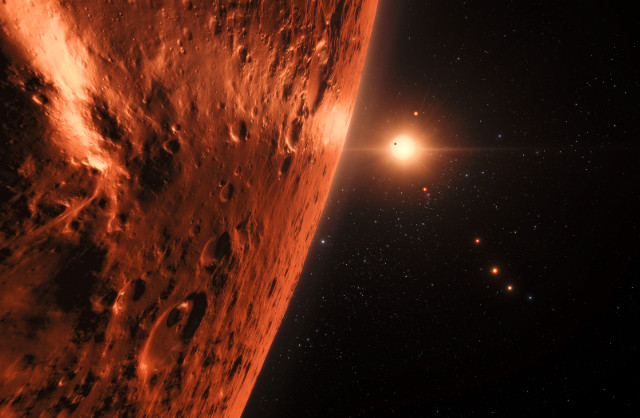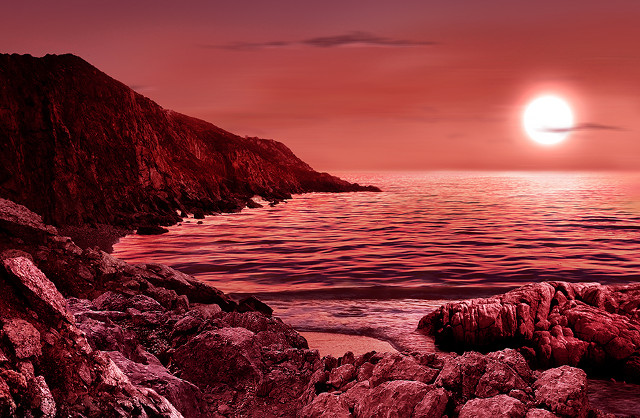
An article published in “The Astronomical Journal” describes a research in which an estimate of the presence of water on the seven planets of the star system TRAPPIST-1 is provided. A team of astronomers led by Vincent Bourrier of the Observatoire de l’Université de Genève, Switzerland, used the Hubble Space Telescope to examine that system concluding that its outer planets are more likely tyo still have a substantial amount of water. They include the three planets in the system’s habitable zone.
The ultra-cool dwarf star TRAPPIST-1’s system has been increasingly the focus of many researchers’ attention for a couple of years and especially since the presence of seven rocky planets was confirmed in February 2017. Various researches based on observations made with various space and ground-based telescopes are providing more and more information on these planets but the analyzes of all the data are long and complex. The consequence is that progress is slow but that’s normal as they concern a whole solar system even when focused on a specific element.
One of the key questions about the TRAPPIST-1’s planets concerns the presence of water and at the theoretical level the various researches offered some optimistic and other pessimistic clues. Given the planets’s positions, in theory it’s possible that there’s liquid water at least in some areas of all of them. On the other hand, the star’s strong activity, with very violent flares especially when it was young, suggested that if originally there was water on the planets, they could have lost huge amounts of it over time.
Now an international team of astronomers examined the amount of ultraviolet radiation that strikes the planets of TRAPPIST-1 to try to figure out how much water there may be on their surface. A strong amount of ultraviolets can break the molecules into hydrogen and oxygen that can then even escape from the atmosphere.
Hydrogen around the exoplanets can be detected by the Hubble Space Telescope and is a possible indicator of the presence of water vapor in their atmosphere that is broken up over time in the elements that make up it. Unfortunately in this case the information obtained were too vague to be useful.
Another article published in the magazine “The Astronomical Journal” describes a research on the role of ultraviolet emissions on the possible birth of life forms on planets that orbit red dwarfs. According to a team led by Sukrit Ranjan of the Harvard-Smithsonian Center for Astrophysics (CfA), these stars may not emit enough ultraviolet light to generate the chemical reactions needed for the emergence of life forms.
According to the researchers who studied the TRAPPIST-1 system with the Hubble Space Telescope, this star is very small but emits too many ultraviolets at least for the closest planets. Their observations also suggest that if there was water on its planets they lost huge amounts of it.
The two innermost planets, TRAPPIST-1b and TRAPPIST-1c, are the ones that receive the highest amount of ultraviolet light. According to estimates, they may have lost the equivalent of 20 times the Earth’s oceans’ water over 8 billion years. The system’s age is not certain but a recent research indicates that it’s much older than the solar system so it could be 8 billion years old.
The situation is better for the other planets, which may still have water on their surface. The planets indicated as e, f and g are within the system’s habitable zone so that possibility is particularly intriguing. Estimates indicate that the most massive outer planets should be the ones on which the largest amount of water remained. Unfortunately, these are estimates based on limited data so there are many unknowns.
The authors of the research on the TRAPPIST-1 system are the first to say that they need more data and other studies to understand the habitability potential of the various planets. However, it’s a confirmation of how much this system is interesting to test the current theoretical models and to study a real case.



Permalink
Looking forward to when we can detect fotosynteses in support of water detection, on other planet’ s.
And thx for interesting work 🙂
Permalink
Thank you for your appreciation. 🙂
Probably the James Webb Space Telescope will change a lot in our understanding of exoplanets with the possibilities to detect what’s happening on them and if there are signs of at least some biological activities.